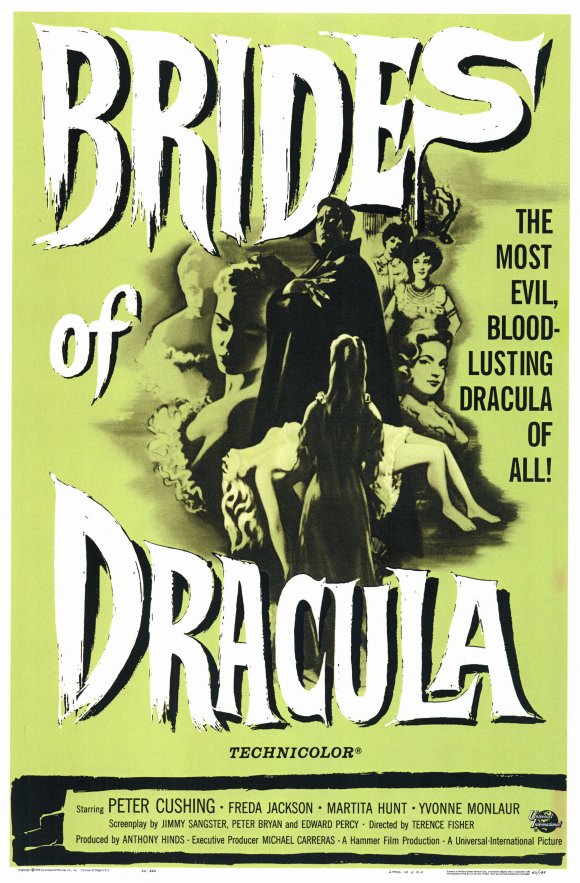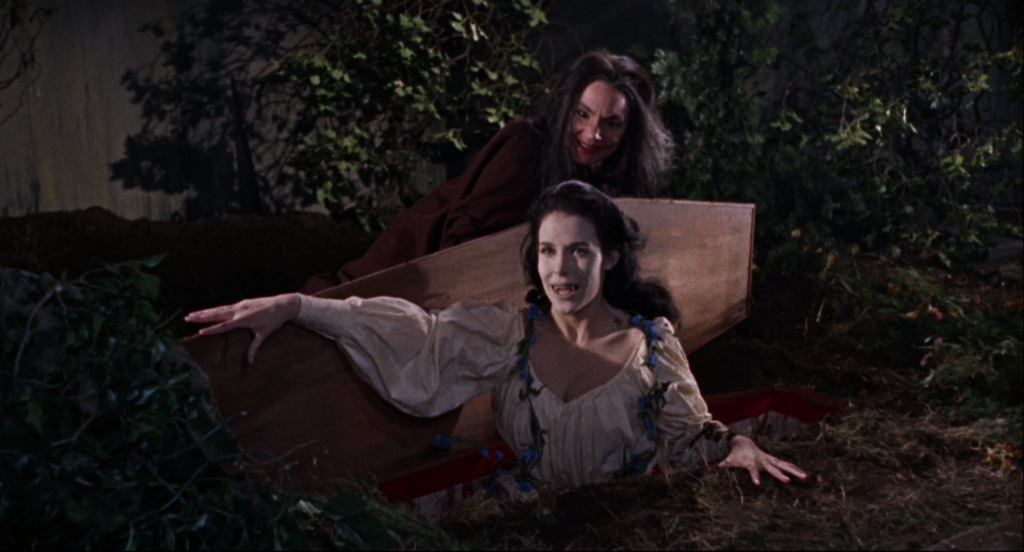
When I think of The Brides of Dracula (1960), first I think of the lighting and rich colors of DP Jack Asher. Asher, who had also photographed Hammer’s The Curse of Frankenstein (1957), Dracula (1958), and The Hound of the Baskervilles (1959) – all classics of the Hammer Gothic style – submerges the Meinster manor in pools of red and blue, creating a dream-realm both dangerous and deeply alluring for the naïve heroine sneaking through its nighttime corridors. Asher blanches the pale faces of the vampire “brides,” and his shadows are so stark that they can kill – which is precisely what happens in the finale. I think of the production design of Bernard Robinson, once again transforming Bray Studios into something mysterious and ancient, and I think of director Terence Fisher, at the top of his game, delivering another gem of elegant horror with his dynamic compositions and knack for steadily developing tension that creeps up on the viewer. Many fans consider The Brides of Dracula to be a high watermark for the studio, or at least very close, ranking consistently toward the top whenever favorite Hammers are discussed. It’s the perfect synthesis of all the elements that made the brand so memorable, released at the peak of the studio’s powers. And if rumors are to be believed and Shout Factory is taking a break from releasing Hammers on Blu-ray, then for Brides, their latest Hammer disc, they’ve chosen to wrap up the line on a high note. Taken from a new 2K scan of the interpositive, the disc ports over some older special features and adds new supplements (including a wonderful, in-depth appreciation of Fisher’s career from the great Richard Klemensen of Little Shoppe of Horrors magazine). This is a major step up from the previous R1 disc of Brides, as a features-free inclusion in Universal’s missed-opportunity Hammer Horror 8-Film Collection. (That disc framed the film as 2.0:1, whereas the Shout disc offers the options of the more accurate theatrical ratios 1.85:1 and 1.66:1.)
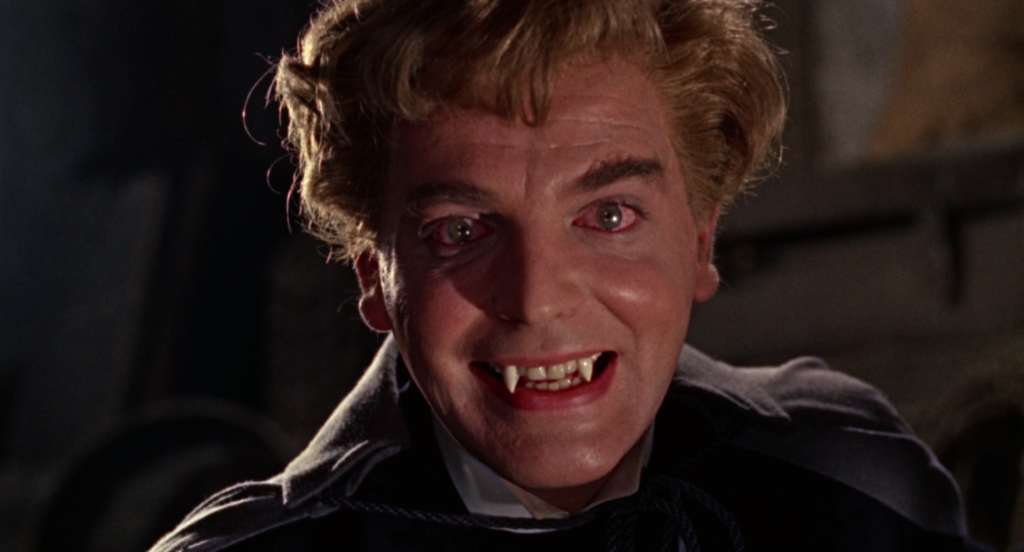
David Peel as Dracula stand-in Baron Meinster.
I’ve always found the narrative approach of Brides appealing, taking a more credible approach to a Dracula sequel than its many follow-ups. As with Universal’s Dracula’s Daughter (1936), Brides follows not a miraculously rejuvenated Count but the original film’s hero, Van Helsing. (As much as I love the other sequels, it’s hard to escape the feeling that Dracula exists for the sole purpose of being killed over and over again.) Yet this was not the original intention; as Marcus Hearn and Alan Barnes note in their book The Hammer Story, an early 1959 draft by Jimmy Sangster called Disciple of Dracula brought back the Count, to once again be played by Christopher Lee. This was rewritten by Peter Bryan and later touched up by Edward Percy – all three writers having their name on the final product, while Dracula disappeared and Van Helsing, played by a returning Peter Cushing, took center stage. Well, he does eventually. The script takes its time with a protracted opening act that deliberately mirrors the first act of Stoker’s Dracula – an innocent in a castle occupied by a vampire – lending Van Helsing’s eventual appearance the sense of relief that you get in the original novel: finally, someone who knows what’s going on and can tackle the problem! French actress Yvonne Monlaur, who starred in the same year’s lower-grade but delightfully bonkers Circus of Horrors, spearheads the first act as Marianne, a schoolteacher traveling to an academy in Eastern Europe who is plucked out of a claustrophobic tavern by a mysterious older woman, Baroness Meinster (Martita Hunt of David Lean’s Great Expectations), and taken to her secluded home atop a forbidding crag. Here Marianne spends a restless night, catching a glimpse of the Baroness’s son (David Peel) standing on a balcony beneath her bedroom window and apparently about to jump to his death. She rushes to his rescue, only to find that he can’t possibly jump – his ankle is bound to a chain. His mother claims that he’s dangerously insane, but Baron Meinster’s charming, sympathetic demeanor tells Marianne otherwise. Fatefully, she steals the key to the chains…
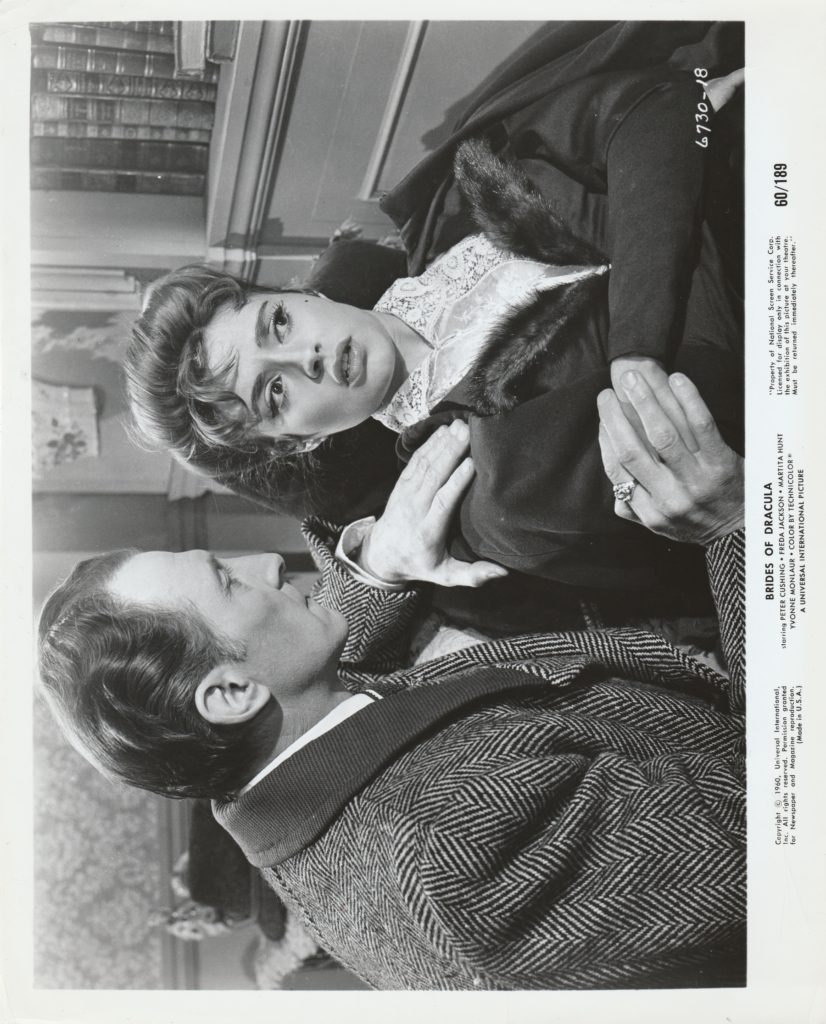
Publicity still with Peter Cushing as Van Helsing and Yvonne Monlaur as Marianne.
This opening sequence is a little masterpiece of visual storytelling, building interest in part through Bernard Robinson dressing cozy Bray Studios in such a way to suggest a manor full of secrets, labyrinthine corridors and staircases. I have no clear map of the Meinster home in my mind, except that it must sprawl, surreal, in all directions, a trick aided and abetted by Asher’s careful lighting. Fisher poses mysteries and striking revelations with skill: what is that man doing on that balcony? – why does the the servant, Greta (Freda Jackson, The Shadow of the Cat), deny his existence? – while Marianne steals the key, what is it that Baroness Meinster is up to? Actually, to that last question, I’m not entirely sure; but for Brides the sensation is more important than the plot, and we’re certainly on the edge of our seat watching both Marianne and the Baroness sneaking and spying. (On this viewing, the film’s first act kept bringing to mind Suspiria – which is another film in which the story is less relevant than style and impact.) Much later in the film, when Van Helsing visits Baroness Meinster, Fisher delivers a terrific moment in which we glimpse her fangs before she hastily covers them, as though shamefully hiding a disfigurement. He might have held back on that revelation, but he shows us those fangs straight away, drawing our attention as much to her character as the suspense of a vampire confrontation. Moments like this stick in my mind as much as the more overt moments of horror, as when Greta, bent over and hair covering her face, squeals with delight while urging one of the undead to claw its way out of the earth.
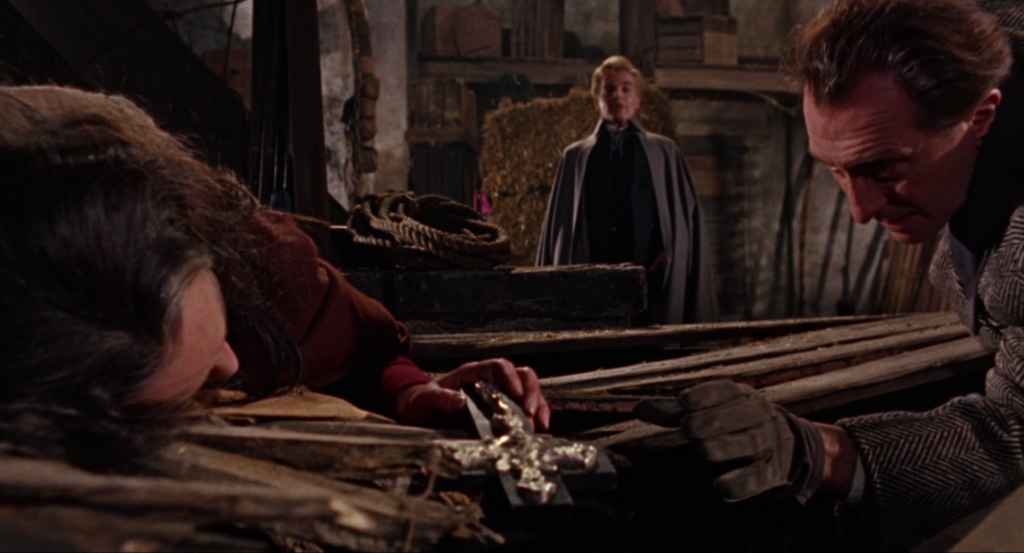
Terence Fisher-brand suspense: Van Helsing reaches for a crucifix about to plummet into a shaft while Meinster approaches.
And then, of course, there’s Cushing, who had just come off playing Sherlock Holmes in Baskervilles with the same intensity and energy that he brought to his performances as Baron Frankenstein and Dr. Van Helsing. When we last left Van Helsing, he was having a swashbuckler-worthy duel with Dracula in his castle; now he’s hunting down the remnants of the plague unleashed by the Count. Marianne allows herself to be romanced – and proposed to – by the liberated Baron Meinster, but he’s unfaithful: her friends at the Girls’ Academy are preyed upon by night. Meinster may just be a hungry vampire, but his liaison with Andree Melly (who sadly passed away in January of this year) foregrounds another implication when the bitten woman tells Marianne seductively: “Please be kind to me. Say that you forgive me for letting him love me…We can both love him, my darling.” Perhaps this is what the Baroness was warning Marianne against – her son just isn’t good husband material. Van Helsing eventually hunts down Meinster and his harem at an old windmill, which leads to an indelible climax in which, just to kick things off, the unthinkable happens: Van Helsing finally succumbs to the vampire’s bite. How he efficiently copes with this problem is one of the reasons why I love the character, Cushing’s performance, and this marvelous movie in general.
